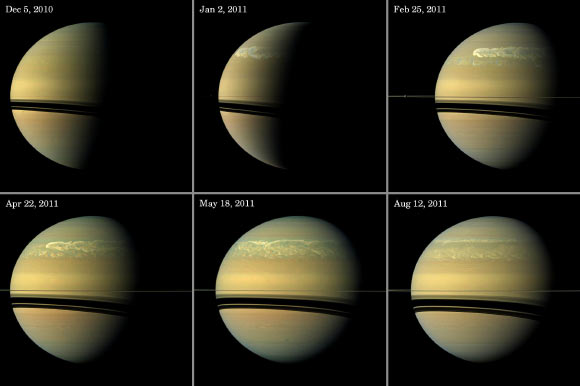Planetary researchers studying data from NASA’s Cassini spacecraft have found the solution to the mystery of why Saturn seethes with massive storms every 20 to 30 years.

This series of images from NASA’s Cassini spacecraft shows the development of the largest storm seen on the planet since 1990. These true-color and composite near-true-color views chronicle the storm from its start in late 2010 through mid-2011, showing how the distinct head of the storm quickly grew large but eventually became engulfed by the storm’s tail. Also visible in these images are several of Saturn’s moons and the shadows cast onto the planet by moons. For example, the planet’s second largest moon, Rhea, can be seen in the Feb. 25 view. These views were acquired at distances ranges from 1.4 million miles (2.2 million km) to 1.9 million miles (3.0 million km) from Saturn and at Sun-Saturn-spacecraft, or phase, angles of 41 degrees to 99 degrees. Image credit: NASA / JPL-Caltech / Space Science Institute.
Six giant storms, also called Great White Spots, have been observed on Saturn since 1876, recurring every two to three decades and alternating between mid-latitudes and the equator.
Cassini spacecraft and ground-based telescopes tracked the most recent of these storms from December 2010 to August 2011. During that time, the storm exploded through the clouds, eventually winding its way around the planet.
Now, scientists at the California Institute of Technology, Pasadena, have described the effect they believe is responsible for the periodic outbursts.
The idea is that water vapor is heavier than the hydrogen and helium that make up the bulk of the planet’s atmosphere, so once each giant storm dumps its huge mass of rain, the air within the clouds is left lighter than the atmosphere below. For a time, this situation shuts off the process of convection that creates new clouds and storms.
“For decades after one of these storms, the warm air in Saturn’s deep atmosphere is too wet, and too dense, to rise,” said Cheng Li, the lead author on the study published in the journal Nature Geoscience.
“The air above has to cool off, radiating its heat to space, before its density is greater than that of the hot, wet air below. This cooling process takes about 30 years, and then come the storms.”
The episodic nature of the Great White Spots indicates the planet’s deep atmosphere contains more water, relative to the other atmospheric constituents, than Jupiter.
“Saturn’s extra-wet interior might explain why the planet has such epic tantrums, whereas Jupiter does not. If Saturn’s deep atmosphere were drier, scientists would expect continuous, smaller storms, as observed on Jupiter,” Li said.
“Instead, Saturn’s outbursts are episodic and quite explosive.”
_____
Cheng Li & Andrew P. Ingersoll. Moist convection in hydrogen atmospheres and the frequency of Saturn’s giant storms. Nature Geoscience, published online April 13, 2015; doi: 10.1038/ngeo2405







